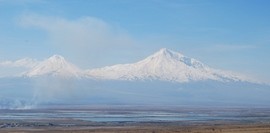
For Immediate Release
Yerevan, Armenia – On March 18, the USAID Clean Energy and Water Program (CEWP) presented to water sector stakeholders the findings of the Study of Groundwater Resources in the Ararat Valley, Armenia. Participants included Deputy Prime Minister/Minister of Territorial Administration Armen Gevorgyan, Head of USAID/Armenia Karen Hilliard, officials from the Ministries of Nature Protection, Agriculture, Energy and Natural Resources, as well as representatives of the regional governments of Ararat and Armavir provinces, the Armenian National Assembly, and sector related scientific institutions.
The level of groundwater resources and groundwater springs reserves in the Ararat Valley has significantly dropped over the last 6-8 years, according to the study. Over 30 communities in the valley suffer from shortages of potable and irrigation water, which leaves a negative imprint on the socio-economic and health conditions of the villages. The study voices the strong need for political action on the part of the Armenian Government to address these issues through improved management and control mechanisms, including the introduction of water conservation measures. These steps will ultimately help to remedy the situation and restore the level of groundwater resources in the Ararat Valley – the country’s vital agricultural hub.
The study was a one-year collaborative effort of international and local experts, including specialists from the ArmWaterProject Institute and Mel-Hov companies. Completed in February 2014, the assessment reviews and analyzes previous studies of the groundwater balance, past and present groundwater use in the Ararat Valley, existing aquifers (layers of penetrable rock or sand that can absorb and hold water), and water extraction and recharge rates from the aquifers. The study also provides important recommendations for sustainable use of existing groundwater resources considering current and projected water demand in the valley.







Comment
Make a general inquiry or suggest an improvement.